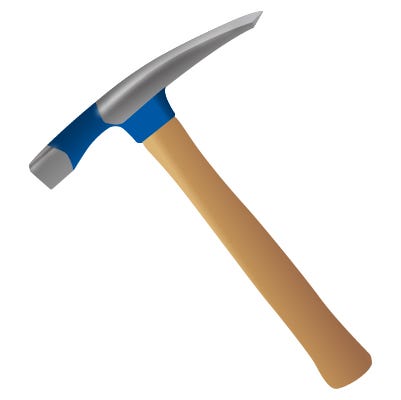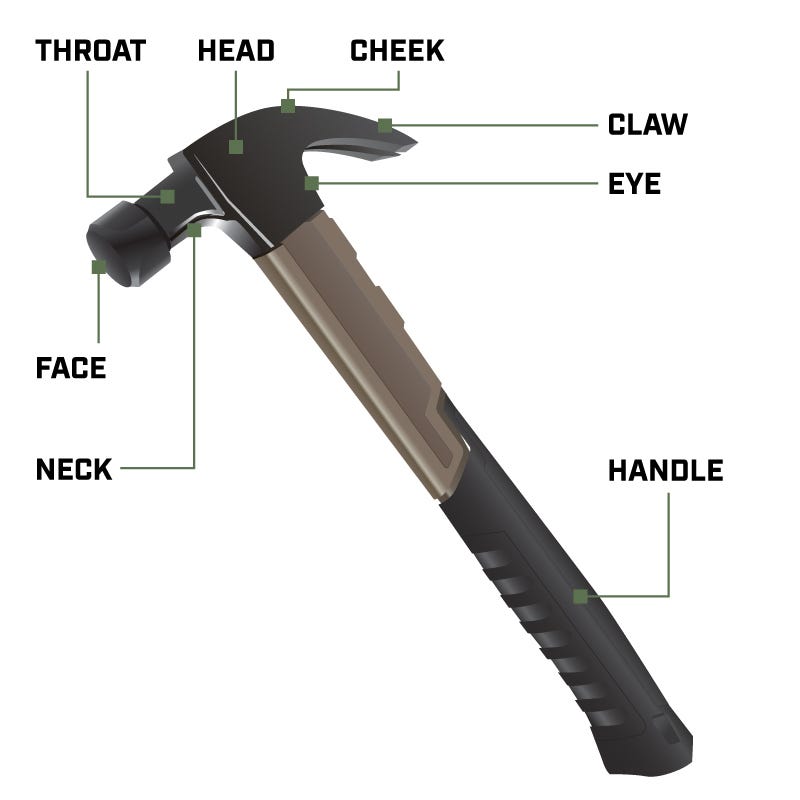A trim hammer is a specialized tool for precise nailing and trimming tasks. It features a smaller head and lighter weight.
Trim hammers are essential in woodworking and carpentry, providing accuracy in tight spaces. These hammers are ideal for detailed work such as crown molding, baseboards, and delicate trim. Their smaller size and lighter weight make them easy to handle, reducing fatigue during prolonged use.
With a trim hammer, you can achieve clean, professional finishes on various projects. They often have a smooth face to prevent marring surfaces, ensuring high-quality results. Whether you are a professional carpenter or a DIY enthusiast, a trim hammer is a valuable tool for detailed and accurate work.
Introduction To Trim Hammer
Trim hammers are essential in many industries. They help with precision tasks. This section introduces the trim hammer and its uses.
Definition
A trim hammer is a specialized tool. It has a flat head and a narrow claw. The head is typically lightweight. This allows for precise control. The hammer is designed for fine work. It is ideal for trimming and finishing tasks. The handle is often made of wood or fiberglass. This ensures a firm grip.
Historical Background
The trim hammer has a rich history. It evolved from basic hammers used centuries ago. Early craftsmen needed precise tools. They modified standard hammers. Over time, the trim hammer was developed. It became popular in the construction industry. Its design improved with technology. Today, it is a must-have tool for many professionals.
| Feature | Description |
|---|---|
| Head | Flat and lightweight |
| Claw | Narrow for precision |
| Handle | Wood or fiberglass |
Trim hammers are versatile. They are used in carpentry, roofing, and other trades. Their design allows for detailed work. This makes them invaluable for professionals.
Design Features
A trim hammer is a specialized tool used in various applications. Its design features make it unique and efficient. Let’s explore the key design elements: handle material, head shape, and weight considerations.
Handle Material
The handle material of a trim hammer is crucial. It affects the hammer’s durability and user comfort. Common materials include wood, fiberglass, and steel.
- Wood: Provides a natural grip and absorbs shock.
- Fiberglass: Offers excellent strength and reduces vibration.
- Steel: Extremely durable but can be heavy.
Head Shape
The head shape of a trim hammer influences its functionality. Different head shapes serve different purposes.
| Head Shape | Purpose |
|---|---|
| Flat Head: | Ideal for general striking and driving nails. |
| Curved Claw: | Useful for removing nails and prying. |
| Ball Peen: | Best for metalworking and shaping. |
Weight Considerations
Weight is a critical factor in a trim hammer’s design. It affects both usability and precision.
- Lightweight Hammers: Easier to handle, suitable for delicate tasks.
- Medium Weight: Offers a balance of control and power.
- Heavy Hammers: Provide more force, ideal for heavy-duty work.
Choosing the right weight enhances efficiency and reduces fatigue.
Types Of Trim Hammers
Trim hammers are essential tools for detailed carpentry work. These specialized hammers come in various types, each designed for specific tasks. Understanding the different types of trim hammers can help you choose the right one for your project.
Claw Trim Hammer
The Claw Trim Hammer is the most common type. It has a dual function with a flat striking surface on one side and a curved claw on the other. The flat side drives nails, while the curved claw removes them. This hammer is versatile and perfect for many small jobs.
- Weight: Usually lighter for easy handling
- Material: Often made of steel or fiberglass
- Handle: Ergonomic grip for comfort
Finish Trim Hammer
The Finish Trim Hammer is designed for delicate tasks. It has a smooth, polished face to avoid marking the wood. This hammer is ideal for driving finish nails or brads.
- Weight: Lightweight for precision
- Material: High-quality steel
- Handle: Often wood for better control
Specialty Trim Hammers
Specialty Trim Hammers cater to specific needs. They include magnetic hammers, upholstery hammers, and more. Each has unique features to solve particular problems.
| Type | Use | Features |
|---|---|---|
| Magnetic Hammer | Holds nails in place | Magnetic head |
| Upholstery Hammer | Works with tacks | Small, lightweight |
| Ball Peen Hammer | Metalworking | Rounded head |
Choosing the right trim hammer can make your work easier and more efficient. Whether you need a Claw Trim Hammer for general tasks, a Finish Trim Hammer for precise work, or a Specialty Trim Hammer for unique jobs, there is a tool designed for your needs.

Credit: specopstools.com
Primary Uses
The trim hammer is a versatile tool used in many tasks. It offers precision and control that other hammers do not. Below are its primary uses in different fields.
Woodworking
In woodworking, the trim hammer excels in detailed tasks. Its small head allows for precision nailing and trimming. Woodworkers often use it for:
- Fine carpentry
- Cabinet making
- Furniture repair
Its lightweight design reduces hand fatigue during long projects.
Metalworking
Metalworkers rely on the trim hammer for precision tasks. It helps in shaping and smoothing metal edges. Key uses include:
- Metal trim installation
- Sheet metal work
- Small metal repairs
The hammer’s narrow face allows for detailed work without damaging the material.
Home Improvement
The trim hammer is also a favorite in home improvement. Its compact size is perfect for tight spaces. Homeowners use it for:
- Installing baseboards
- Fixing moldings
- General small repairs
This tool is essential in every DIY toolkit for small, precise tasks.
Techniques For Using A Trim Hammer
Using a trim hammer effectively requires skill and practice. Mastering the right techniques ensures precision and safety. Here are some essential techniques for using a trim hammer.
Proper Grip
Holding the trim hammer correctly is crucial. Grip the hammer handle firmly but not too tight. Place your thumb along the side of the handle. This provides better control and reduces fatigue.
Always keep your wrist straight while gripping. This helps in delivering accurate and strong blows. A proper grip also minimizes the risk of injury.
Swing Motion
The swing motion should be smooth and controlled. Lift the hammer to shoulder height, then bring it down in a straight line. Aim for the center of the nail or surface.
Maintain a consistent rhythm. This ensures uniformity in your work. Avoid jerky or forceful swings as they can cause mistakes or damage.
Safety Tips
Safety is paramount when using a trim hammer. Wear safety goggles to protect your eyes from flying debris. Use gloves to safeguard your hands.
Ensure the work area is clear of any obstacles. Keep your fingers away from the striking zone. Always check the hammer for any damage before use.

Credit: www.reddit.com
Selecting The Right Trim Hammer
Choosing the right trim hammer can make or break your project. Understanding your needs helps you select the best tool.
Project Requirements
Consider the specific project requirements. Different tasks need different types of trim hammers. For small, delicate work, choose a lightweight hammer. For larger tasks, a heavier hammer is better.
- Light tasks: lightweight hammer
- Heavy tasks: heavy hammer
Material Compatibility
Check the material compatibility of the hammer with your project. Some hammers work well with wood, others with metal. Ensure your hammer matches your materials.
| Material | Recommended Hammer |
|---|---|
| Wood | Claw Hammer |
| Metal | Ball-Peen Hammer |
Ergonomics
Consider the ergonomics of the trim hammer. A good grip reduces hand fatigue. Look for hammers with cushioned handles.
- Check the grip
- Test the weight
- Look for cushioned handles
Ergonomic hammers make your work easier and safer.
Maintenance And Care
Taking care of your trim hammer is essential. Proper maintenance ensures its longevity and effectiveness. Here’s a guide to help you keep your trim hammer in top shape.
Cleaning Methods
Regular cleaning prevents rust and damage. Follow these steps to clean your trim hammer:
- Wipe the hammer with a clean cloth after each use.
- Use a brush to remove dirt from the head and handle.
- Apply a light coat of oil to the metal parts to prevent rust.
Cleaning your hammer regularly keeps it looking new and working well.
Storage Tips
Proper storage prevents damage and extends the hammer’s life. Consider these tips:
- Store the hammer in a dry place to avoid rust.
- Hang it on a pegboard to keep it off the floor.
- Use a tool chest for added protection.
Storing your hammer correctly ensures it stays in good condition.
Repairing Damage
Even with care, your hammer might get damaged. Here’s how to fix it:
- Check the handle for cracks. Replace it if needed.
- Sharpen a dull head using a file.
- Tighten any loose parts with a wrench.
Repairing your hammer helps it last longer and work better.
Following these maintenance and care tips will ensure your trim hammer stays in excellent condition for years to come.

Credit: specopstools.com
Common Mistakes To Avoid
Using a trim hammer can seem easy. But, many people make errors. These mistakes can lead to poor results. Here are some common mistakes to avoid while using a trim hammer.
Using Wrong Type
One common mistake is using the wrong type of trim hammer. Each hammer type is designed for specific tasks. Using the wrong hammer can damage the surface. Always choose the right tool for the job.
| Hammer Type | Best For |
|---|---|
| Finishing Hammer | Delicate trim work |
| Framing Hammer | Heavy-duty tasks |
Improper Handling
Improper handling is another mistake. Holding the hammer too tightly can cause fatigue. This can lead to mistakes. Hold the hammer with a relaxed grip.
- Use a balanced grip
- Hold the handle near the end
- Keep your wrist straight
Neglecting Maintenance
Many people neglect hammer maintenance. A rusty or dirty hammer can cause problems. Regular cleaning and oiling are essential. Check the hammer for any damage before use.
- Clean the hammer regularly
- Oil the moving parts
- Inspect for damage
By avoiding these mistakes, you can use your trim hammer effectively. This ensures better results and a longer tool life.
Frequently Asked Questions
What Is A Trim Hammer?
A trim hammer is a specialized tool used for finishing work and precision tasks.
How Is A Trim Hammer Used?
It is used for delicate work, fine nailing, and trimming tasks in carpentry.
What Are The Benefits Of A Trim Hammer?
Provides precision, reduces damage to surfaces, and is ideal for detailed carpentry work.
Can A Trim Hammer Be Used For Framing?
No, it is not suitable for heavy-duty tasks like framing; it’s designed for precision work.
What Makes A Trim Hammer Unique?
Its lightweight design and small head make it perfect for detailed, precise tasks in woodworking.
Conclusion
A trim hammer is a versatile tool for detailed woodworking and metalwork. Its lightweight design ensures precision. Whether you’re a professional or DIY enthusiast, a trim hammer is indispensable. Master its use to enhance your craftsmanship. Invest in a quality trim hammer for better results on your projects.
Recent Posts
Maintaining clean gutters is essential for preventing water damage to your home, and choosing the best ladder for cleaning gutters can make the job much easier and safer. With so many options on the...
Best Ladder for Cleaning Caravan Roof: Top Picks for You Every Adventure!
Today we will discuss the best ladder for cleaning caravan roof. Cleaning caravan roofs is one of the crucial tasks.After many days, a caravan roof can get dirty by debris, dirt, and grime. These can...
